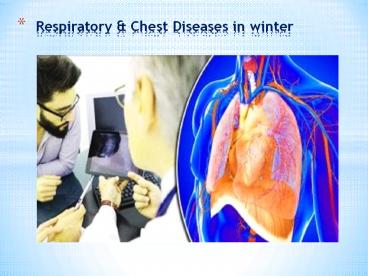Respiratory & Chest Diseases In Winter - PowerPoint PPT Presentation
Title:
Respiratory & Chest Diseases In Winter
Description:
0Winters bring pleasant weather and festive season but also bring a wide spectrum of respiratory and chest diseases. As the winters begin, the cold winds penetrate our warm bodies, many people become prone to mild and severe chest diseases. – PowerPoint PPT presentation
Number of Views:107
Title: Respiratory & Chest Diseases In Winter
1
Respiratory Chest Diseases in winter
2
Winters bring pleasant weather and festive season
but also bring a wide spectrum of respiratory and
chest diseases. As the winters begin, the cold
winds penetrate our warm bodies, many people
become prone to mild and severe chest
diseases. These diseases can vary from being mere
allergies to severe problems resulting in a
fatality. Whatever is the extremity of the
condition the person should take immediate
action and consult a physician. Following are a
few common chest diseases of winter Common
cold There more than two hundred types of
viruses responsible for a common cold. It is
contagious and can be transmitted through air, or
infected surfaces. The best ways to invite common
cold is touching your nose, eyes, mouth or
sensitive areas with the hands that have touched
some infected surface. The primary symptoms of
common cold are a runny nose, sore or strep
throat, sneezing, nasal congestion, coughing, and
fever. Bronchitis Bronchitis is caused by
inflammation within the respiratory passages
leading air to the lung. The reason for such
inflammation can be filling with mucus in some of
those passages. This condition prevents fresh air
to smoothly pass through the passages, resulting
in wheezing, short and shallow breath and
retractions. Sometimes the area around the
nostrils may also sink inwards while breathing.
3
Pneumonia Pneumonia cannot be diagnosed without
detailed imaging such as an X-ray. The alveoli or
small oxygen absorbing pockets in the lungs are
filled with fluid due to some bacterial infection
causing fever, constant coughing, limited
appetite and episodes of retractions. Sinusitis
Common cold is sometimes followed by sinusitis.
The infections when getting severe, irritate the
inner membranes of the nasal passage and cause
them to swell. The swollen sinus is not able to
properly discharge mucus, worsening the
problem. Flu Flu is also known as influenza is
a severe kind of common cold. The body becomes
the achy, runny nose, nasal congestion, and
fatigue and chest pain. Respiratory Syncytial
Virus RSV can lead to long term illness of
bronchitis and pneumonia, mostly in infants and
children. The illness can cause severe chest
pain. Whooping Cough While coughing, when it
makes a heavy whooping sound. The same heavy
sound is also there when the affected person
inhales and exhales air. There is mostly a
coughing fit and usually affects children.
4
- Croup This cough lasts for a couple of weeks and
the sound is similar to bark. It is more
prevalent in children an can cause pain in the
chest due to rough coughing. - HOW TO PREVENT RESPIRATORY DISEASES IN WINTERS-
- Avoid exposure to extreme weather conditions.
- Keep your body covered and wear proper adequate
clothing for winters. - Avoid polluted areas as fog mixed with smoke i.e
smog is extremely dangerous for the respiratory
tract and can lead many serious ailments. - Maintain proper hygiene, take bath regularly and
wash your hands properly before every meal. - Eat freshly prepared food only and avoid
refrigerated or stale foods. - Remain hydrated and take plenty of fluids if the
form of warm water, fresh juices, soups, tea
other beverages etc. - Avoid direct contact like touching hands, hugging
etc. with people who are infected with a common
cold or other respiratory diseases. - Cover your mouth and nose while sneezing or
coughing, preferably with a tissue which should
be discarded after use. - Avoid smoking and also prevent yourself from
indirect second-hand exposure to smoking.
5
- TREATMENT-
- Usually, no specific treatment is available but
supportive symptomatic treatment is done as the
infection is controlled by the body immune system
only. - Multivitamins can be taken to boost the immune
system. Also, there is a definite role of Vitamin
C supplementation, either by medications or
natural foods rich in vitamin C like lemon, Guava
etc. - Antipyretics and antihistamines are given for
symptomatic relief of fever, body aches, and
running nose. In addition, some nasal
decongestants are also recommended. - Steam inhalation is a good measure to open up the
blocked respiratory tract and sinuses. - Other Home remedies like ginger, honey, Tulsi and
green tea etc. are also helpful. - Breathing exercises are recommended if there is
dyspnoea or in patients with some pre-existing
respiratory diseases.
6
- The flu vaccine is also available in the market
which is recommended mainly in high-risk prone
professionals and is helpful only if taken in
advance. also, the strain of the virus keeps
mutating rapidly so one vaccine may not be
helpful in all diseases. - Article Resource - https//www.apexdiagnostics.in/
blog/respiratory-chest-diseases-in-winter/































